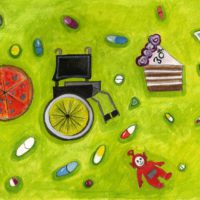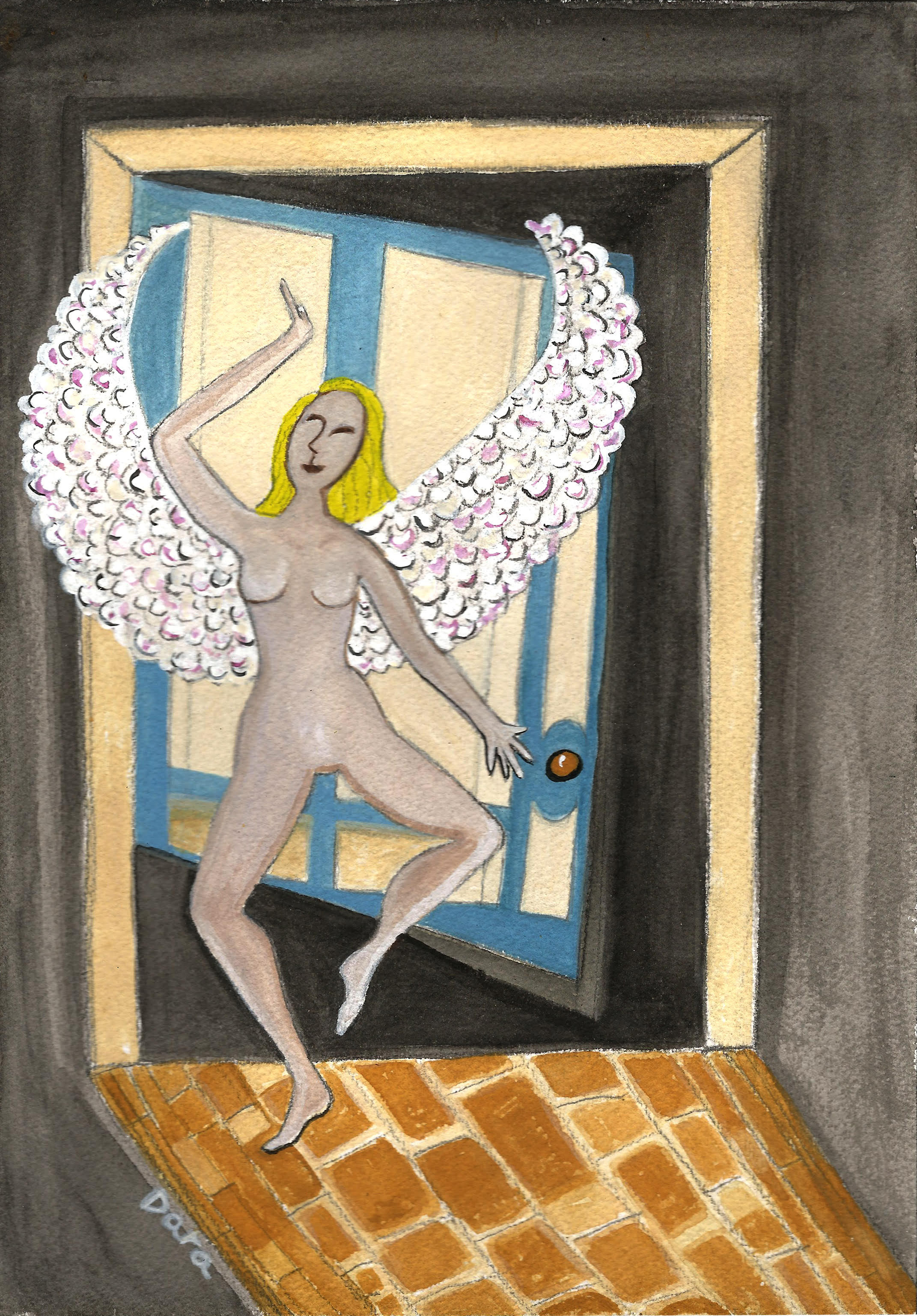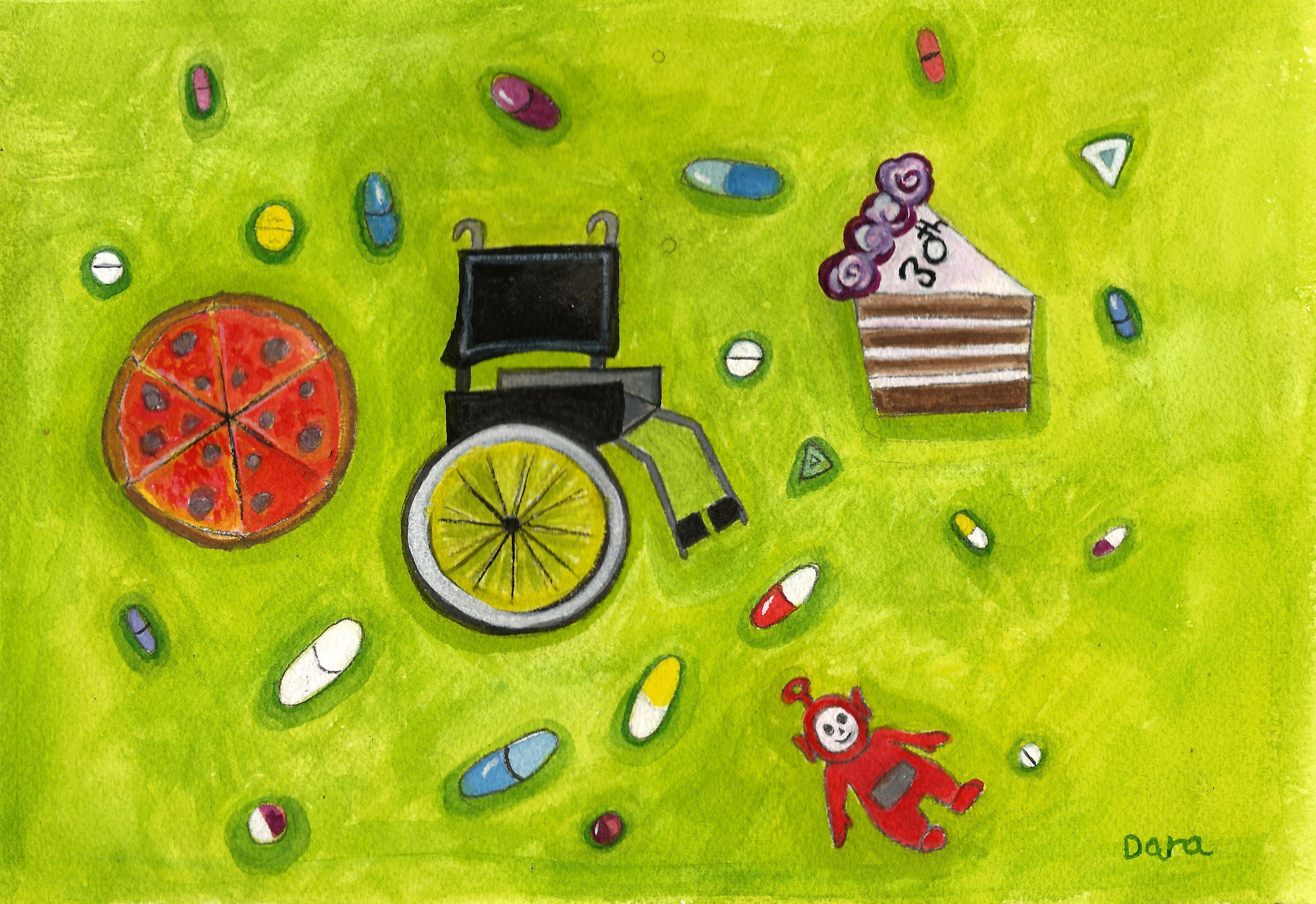The bright morning light startled me. My husband had already left for work. The baby monitor was quiet. My six-month-old son had never slept this late. I tiptoed into the hallway, cringing every time the wooden floorboards creaked, and stopped in front of Benjamin’s door. Silence. Parents in my Internet support group said the average lifespan for children with lissencephaly was two years.
As I reached for the glass doorknob, I pictured myself standing in Benjamin’s doorway discovering his blue, breathless body. I froze. If I kept the door closed, I could choose to believe Benjamin was alive, but I was uncomfortable lingering in a state of not knowing. I put my ear to the door. Isn’t he ready to nurse while we rock in the glider staring at each other? Benjamin’s warm brown eyes and laughter make this life bearable. I grasped both sides of the doorframe and whispered, “Please don’t leave me, beauty boy.”
My quivering breaths filled the silence. Maybe it would be better if Benjamin died before needing a feeding tube, a tracheotomy, or uncontrollable seizures further damaged his malformed brain. Before repeated pneumonias would “get him.” The neurologist’s words wouldn’t leave me. “He’ll probably never walk, talk, or use his hands, but more importantly I have no idea what his cognitive functioning will be.”
I held my breath and turned the doorknob, unsure of what I was hoping to find. I paused in the doorway. Benjamin’s eyes were closed. His skin color was normal. I exhaled when his tiny hand moved. I wanted him to live. My muscles ached. As I attempted to shower away the guilt and grief, I wondered if today would be the day my tears ran out before the hot water.
My obsession with death and doorways began years before Benjamin was born—two weeks before my ninth birthday. Sometime in the dark hours of the morning, my mother’s screams woke me. I reached the threshold of my parents’ bedroom and saw my brother, hours from his nuptials, administering CPR to my father. Neighbors and the firemen from across the street gathered and escorted me out of the apartment. On my way down the narrow staircase, I squeezed past one of our parish priests. I knew why a priest would be there. After administering last rites, he counseled my brother and his fiancée: “Your father would have wanted you to go through with the wedding.” So they did. My mother dressed and posed for pictures. Makeup couldn’t cover her red eyes. She never made it to the reception.
I always believed nothing could be harder than witnessing my father’s death. I was wrong. Motherhood is harder. After the neurologist diagnosed Benjamin, I glared up to heaven, fired my father and all my Italian ancestors. They were useless guardian angels. I’m still not speaking to them or any other saintly beings, but many friends have argued I’d been primed for this version of motherhood. Somewhere between irony and divine intervention lies the truth about why I deserted my life as a professional modern dancer, returned to school for a master’s in special education, and then had a son more handicapped than any child I’d ever taught.
While my degree in learning disabilities and experience as a preschool teacher helped me manage Benjamin’s educational needs, it didn’t prepare me to mother in an indefinite state of anticipatory loss. Thanks to the miracles of modern-day medicine, children like Benjamin are living longer than nature intends. Today, I have stood outside of Benjamin’s bedroom door, bracing to see death, for nineteen years. If it weren’t for my degree in dance, I wouldn’t have survived.
Whenever I lift Benjamin, to avoid injury, I use lessons I learned in dance. I stand with my weight on both feet, bend my knees over my second toes, engage my stomach muscles, and send energy equally down through my feet and up through my head. Other lessons took longer.
Every morning before I enter Benjamin’s room, I still bow my head, take a deep breath, open the door, pause to scrutinize his skin color, and wait for any sign of movement. I tiptoe around, removing the stuffed cats, bunnies, and Teletubbies dolls he loves to sleep with. I lean in close and whisper, “Good morning, beauty boy.” He always smiles before opening his eyes, even though he’s minutes from his inevitable first seizure of the day.
I play Here Come the Teletubbies on TV, pull down Benjamin’s quilt, grab the hospital pad under his stiff body, and slide him towards the edge of the mattress. As I undress and diaper my son, I apply ointment to the scars from his surgeries: scoliosis, hip, tendon lengthening, foot straightening, and femur fracture repair. I put cream around his feeding tube. A seizure causes Benjamin’s arms to shoot outward. He gasps. While monitoring the length and severity of the seizure, I pantomime the Teletubbies. He laughs. I look into his eyes, “I love you.” He smiles. Benjamin’s warm brown eyes stare into mine as he attempts to copy my words, “Ahhhhhhhh Laaaaaaa.”
Benjamin’s not thinking of the surgeries, daily seizure medications, and emergency rectal Valium I’ll administer if this intermittent seizure morphs into something that steals his ability to look at me when I call his name. Benjamin’s not aware of the risk of sudden death from epilepsy. He’s not focusing on his pulse ox monitor, feeding machine, suction machine, nebulizer, or wheelchair. He’s not rehashing sleepless nights with fever, congestion, reflux, vomiting and pneumonia. Benjamin’s not even thinking about the next electrical jolt just seconds away. He is grateful for this moment watching me sing and dance to the Teletubbies.
Once, when I was dancing in college, I crashed into a speaker hidden backstage behind a curtain. A blue, baseball-sized lump formed on the outside of my lower left leg. My kinesiology teacher marveled, “You were an inch away from shattering your tibia.” With several performances left, my time off stage consisted of ice, elevation, ibuprofen, and gratitude for escaping a catastrophic injury.
The ability to perform while injured has less to do with adrenaline and more to do with acceptance. I didn’t ignore the pain in my leg. I gave it the attention it deserved. Fortunately, the injury didn’t hamper my ability to execute movement nor cause me to compensate and strain other body parts. If that had been the case, I would have modified the choreography. No individual dance step is too precious to alter. Modern dance isn’t about the height of a dancer’s leg, or perfectly pointed feet. My role as a dancer was to deflect attention away from myself and concentrate on delivering the choreographer’s message. If I focused only on my injury, then all I would feel and project is pain, but if I allowed myself to acknowledge all the body parts that worked well, then I could move freely and fulfill my purpose.
When Benjamin was eighteen months old, a geneticist told my husband and me, “Benjamin is going to need a feeding tube and fifty percent of children with g-tubes die before they reach ten years old. You have to choose between an aggressive approach or a care and comfort approach.” John and I wanted what all parents want, to give our son the best possible quality of life. However, quality is subjective.
As a full-blooded Italian, Benjamin loved to eat. He strengthened his oral motor skills by chewing everything from pasta and pizza to peanut butter and jelly sandwiches. He never refused a nice slice of chocolate cake. On his tenth birthday, John and I celebrated Benjamin’s g-tube-free years and had long accepted the neurologist’s predictions. Benjamin couldn’t walk, talk, or use his hands, and his cognitive abilities were toddler-like.
Over the next four years, Benjamin’s oral motor skills regressed but he opened his eyes and mouth wide when I placed a spoonful of food in front of him. We pureed his favorite dishes and made substitutions where necessary. Blended manicotti had a much better consistency than pizza. A squirt bottle replaced sippy cups.
Benjamin’s appetite decreased and he left larger portions of food on his plate. In height and weight, he resembled a child half his age which certainly made it easier to lift him from his bed to his wheelchair. Whenever he got sick, though, even with a minor cold, he ate even less and it took weeks to help him regain one pound. So, when he caught the flu and lost seven pounds, John and I pushed aside our fears of invasive medical interventions and agreed to give Benjamin a feeding tube.
While the tube freed Benjamin from feeding struggles and swallowing twenty-seven prescribed pills daily, it also gave him the means to survive further decline. The average life expectancy for children with lissencephaly is now ten years. Benjamin blew by that nine years ago, but despite all their resources, doctors can’t fix his underdeveloped brain, force his body to reach a normal weight, stop his hypertonic muscles from pulling osteoporotic bones out of joint, nor protect his organs from the toxic effects of semi-effective anti-seizure medications. One day, he might lose the ability to swallow saliva. I don’t know where we’ll draw the line, but so long as Benjamin looks into my eyes and laughs between seizures, I will celebrate his determination to live.
Sometimes after yet another obituary notice appears in my lissencephaly Facebook group, I walk around Benjamin’s room looking at his framed Raymond Brigg’s Snowman poster, Beatles’ “Yellow Submarine” snow globe, and Where the Wild Things Are plush toys. I see Benjamin smiling at these things. I hear his laughter as John reads The Big Red Barn for the twelve billionth time. When Benjamin dies, will we leave his room frozen in time or pack everything away? Will I avoid his favorite song, “Sweet Baby James?” Will the words from Goodnight Moon torture me every evening when I lie in bed? Will I feel relieved or lost without the doctor appointments, medication, feeding, and diaper schedules? How will I get through the day when Benjamin’s smile and laughter live only in my imagination? I’m not sure how parents move on after their kids die, but I’m terrified by stories of children like Benjamin celebrating their thirtieth birthdays.
John and I aren’t getting any younger. When we die, Benjamin will need to live in a Medicaid-funded facility. No one in our families can drop their lives to take care of an adult with the needs of an infant. While community residences have replaced institutions, waitlists are thousands long and Medicaid is more fragile now than ever. I would like to believe a facility could uphold the quality of life goals John and I set for Benjamin. I’d like to believe hired staff could compensate for the bond we have with our son, but I don’t.
Benjamin is my first-born son. I don’t want to watch him take his last breath, nor leave him behind to die alone hooked up to machines controlled by a flawed system. Either way it won’t end well, but I can live with this unresolvable conflict because dance taught me to move freely through pain. Pain is not the enemy, but a messenger. Give it the attention it deserves. Then refocus.
When I was nine years old, I met death in a doorway. Hours later, I sat in church mesmerized by the sound of my brother’s vows and my mother’s wails echoing together through the cold, holy air. Love and grief infuse life. Acceptance is a fluid dance. When morning comes, I will stand outside of Benjamin’s door, envisioning his smile, until one of us is no more.
***
Rumpus original art by Dara Herman Zierlein.







